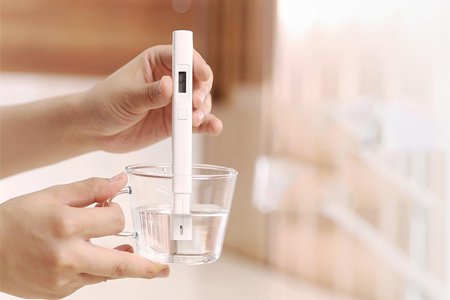When we talk about water quality, the first thing a lot of people think about is TDS values. As a simple, readily available testing tool, TDS meters are often used to determine the quality of water and whether filtered water is ready for drinking. However, few people know which contaminants are measured by TDS. Is this simple water quality test reliable?
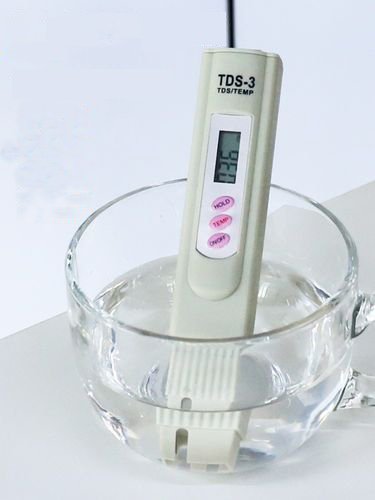
What is TDS?
Total dissolved solids, or TDS, or total dissolved solids, indicates how many milligrams of dissolved solids per liter of water, refers to the water calcium and magnesium ions, suspended particles, protein, microorganisms, colloids, bacteria and viruses, and other dissolved substances in the total content of water.
Popularly speaking, the TDS value represents the content of dissoluble substance impurity in water, the TDS value is bigger, the impurity content that shows water is big, conversely, the impurity content is small.
Unit
- Mg/L, indicating how many milligrams of total soluble solids are present in 1 liter of water.
- A unit of concentration in parts per million of a solution. The number of milliliters of solute in a solution of one million milliliters or the number of grams of solute in a solution of one million grams.
- Conversion relationship: 1 mg/l = 1 ppm

Is high TDS in water harmful?
The higher the TDS value is, the more dissolved substances are contained in the water.
The lower the TDS value, the lower the concentration of Ca, Mg, Na, K plasma in water, and the lower the conductivity.
However, a low TDS value does not mean good water quality, and a high TDS value does not mean bad water quality.
Because total dissolved solids refer to the total amount of solute in the water, both inorganic and organic. However, other contaminants, such as chlorine and bacteria, couldn’t be detected and beneficial natural minerals are classified as “impurities”. Therefore, if the source of the water is unknown, the results of the TDS tests alone will not be used as a criterion for determining whether the water is fit for drinking.
In fact, TDS and water quality are two different concepts.
TDS is only one of many water quality indicators, TDS is mainly used to detect pure water, distilled water, RO film (reverse osmosis membrane) water purifier effluent water quality indicators.
Qualified drinking water must meet microbial indicators (bacterial count), toxicological indicators (concentration of heavy metal ions), sensory properties (color, smell, taste, visible to the naked eye), and general chemical indicators and radioactive indicators.
Healthy and clean drinking water must not contain pathogenic microorganisms, water chemicals, radioactive substances shall not endanger human health, good sensory properties.
Excessive concentrations of heavy metal ions in drinking water pose a great threat to human health, for example, safe concentrations of lead, arsenic, chromium, cadmium, and mercury are allowed to range from 1 to 10 μg/l (1 μg is one-thousandth of a milligram). The size of TDS can not reflect the concentration of harmful heavy metal ions in water at all, as for the number of bacteria in the water, the concentration of organic matter is not high, nitrite concentration is not, exceed the standard, there are no pesticide residues these can not be reflected through the size of TDS. Even if the concentration of bacteria in the water, heavy metal ions exceeded the standard, as long as the water dissolved.
When the concentration of Ca, Mg, Na, K plasma decreases, the TDS value will also decrease.
Is TDS Water Quality Testing Meaningless?
Since TDS cannot directly determine the quality of water, is TDS testing meaningless?
The answer is no. In practice, the water source is identified rather than unknown. TAP water or unnatural bottled water comes from Earth’s surface lakes or rivers, and most of the TDS samples tested are unlikely to be minerals. So, comparing water samples tested with water quality tests can help us tell if the water is clean or not and which is cleaner. For filtered water, we can also use TDS testing to observe the difference between filtered and tap water. The bigger the difference, the better the filtering.
(The situation is different for natural mineral water, which comes from mountains or underground areas that have been shown to contain minerals that are good for you. Therefore, when conducting TDS water quality detection tests, it cannot be compared with tap water or treated bottled water).

TDS test has certain reference significance for water quality detection, especially when there are too many Impurities in the water, TDS will show a large value, simply speaking, TDS value is related to the cleanliness of water quality.
But the reference point is not so absolute, up to a limit (less than 600) can be considered pure water, beneficial ions also pull up the TDS value.
TDS is an exclusive test designed to measure the total dissolved solids in water. Water that exceeds 600ppm is considered contaminated.
However, it should be borne in mind that the TDS value is too high to indicate the existence of water quality problems, but TDS cannot be used as the evaluation standard of healthy drinking water within a limited standard. Healthy drinking water requires calcium, magnesium ions, and other minerals and trace elements beneficial to human health, which will lead to the increase of TDS.
Let’s see the difference between the TDS values of pure water, mineral water, plain water, and tap water.

The TDS value of the purified water is not surprisingly 0

The mineral water has the highest TDS value of 263

The TDS value of plain boiled water after heating is 242.
The result: Expensive mineral water is the least pure, but doesn’t that mean anything.
It should be noted the TDS values of the mineral water are higher than tap water and plain water, but this does not mean that the mineral water is not as pure as they are. Tap water and boiled water in the test to bring us a lot of surprises at least can prove that we use the tap water sample impurities, we should be grateful for this.
Are There Standards for TDS Values?
Many countries have maximum TDS values for tap water, but these vary widely from country to country. TDS has no minimum but a maximum limit (US EPA < 500, World Health Organization Group < 1000). In general, the higher the TDS readings from the tap, the more likely it is that there will be a problem. For those who wish to use TDS values for water quality assessment, the following can be used as a reference.
The higher the TDS value is, the more impurities are contained in the water. These impurities usually refer to the concentration of ca 2 +, mg 2 +, Na +, k + plasma in the water, and can not directly indicate the quality of the water. So, too much TDS (more than 600, etc.) does indicate bad water quality, but the lower TDS is, not equal to water quality is better.
| TDS Value( PPM) | Water Quality |
|---|---|
| 0-9 | Pure Water |
| 10-60 | Mountain spring water, mineral water |
| 60-100 | Purified water |
| 100-300 | Tap Water |
| Above 300 | Polluted water |
US standard TDS values are 0-50 and EU standard TDS values are 0-70.
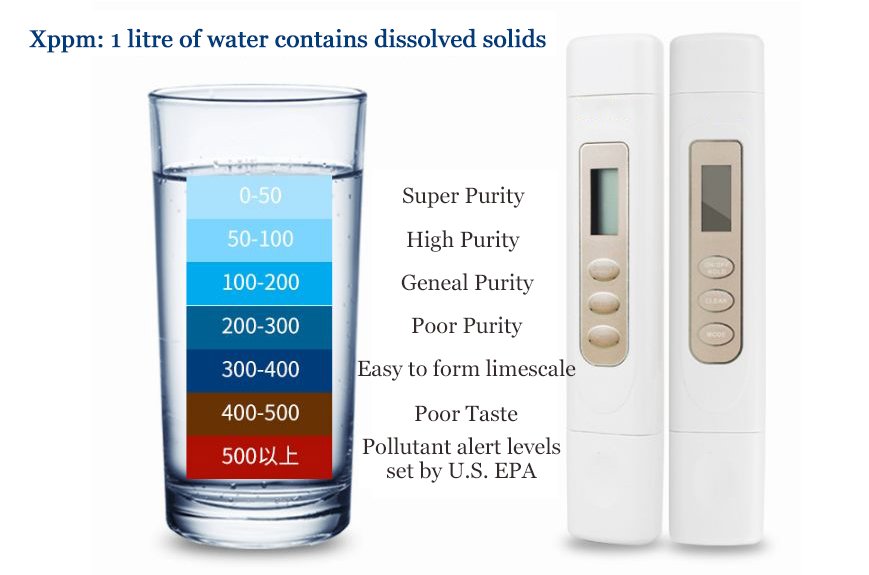
What is the Average TDS Value for Filtered Water?
The TDS value of the filtered water is generally dependent on the filtration technique. Currently, the market is divided into two main water purifiers, one is deep filtration equipment, such as RO machine (distillation is also a deep treatment, but generally used in industrial production). Deep filtration can effectively filter almost all the impurities in the water, and TDS values are usually below 50. The same is true of TDS values for non-natural mineral water sources. The TDS value of distilled water is 0, while the TDS value of barrelled water treated by reverse osmosis is about 30. For other simple filters, the TDS values of the filtered water will hardly change.
How to Use the TDS Meter?
- Open the TDS meter probe cover, press the ON/OFF button.
- Wait until the LCD screen is displayed, put the TDS meter into the water.
- After the numerical stability, press the HOLD button, the values are shown on the LCD screen are TDS values.
- Note: If the TDS counter shows the number of 100 degrees, the total number of positive or negative ions in the water is 100 ppm (tolerance is ± 5 ppm), which means more matter in the water. After testing, wipe the TDS probe clean with dry paper.
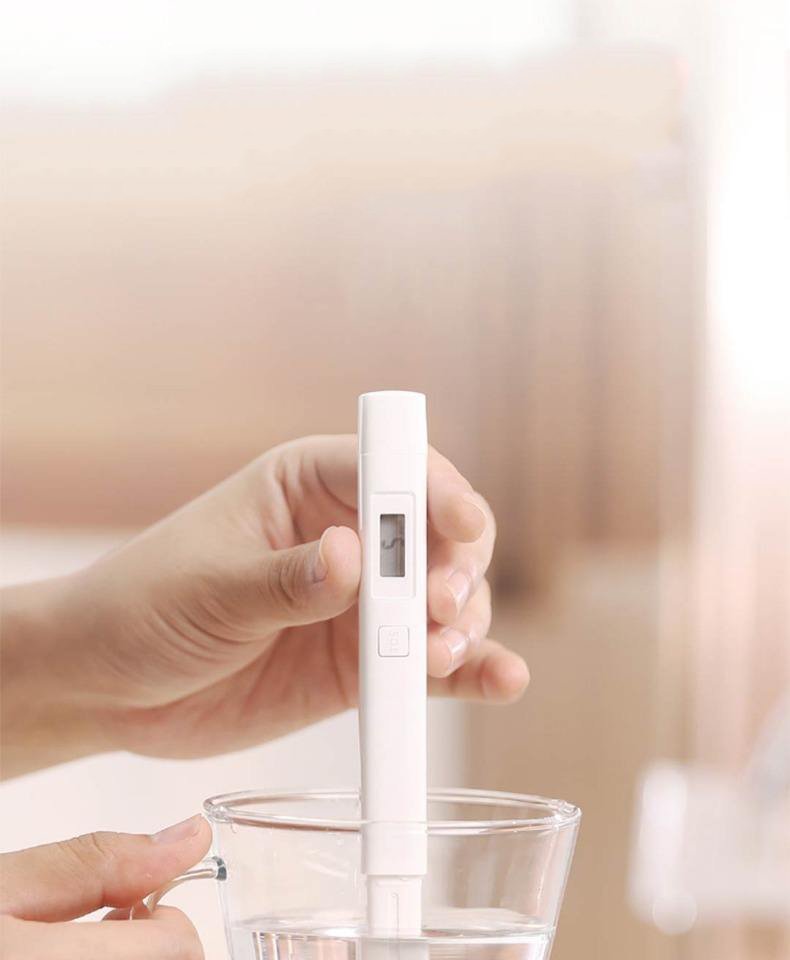
Factors affecting TDS value
- Water Temperature: TDS meter can not be used to measure high-temperature water body (for example hot boiled water) the water temperature should be maintained at about 25 °C, remember, too high temperature will increase TDS value, affect the accuracy.
- Water flow rate: TDS meters should not be used to measure the sloshing of large bodies of water.
- Water Pollution: TDS meters should not be used to measure water with high pollution concentration.
- Sample time: to ensure that the sample is representative, it is best to let the tap run for a period of time (30 seconds) before collecting the sample, as there may be a build-up of material in the pipe that may affect the test.
- The volume of water: 1/4 or 2/5 of the container is sufficient for the volume of the sample.
Remarks
TDS tests help determine if the bottled water (not a natural mineral) is clean and if the reverse osmosis drinking water purifier is working properly.
If your bottled water (which is not a natural mineral type) or a reverse osmosis membrane filtration reading is above 50, the so-called bottled or filtered water has a problem and is not recommended for drinking.
The TDS water quality testing. It’s basic. Laboratory tests are needed if you want to know what exactly is in the water and how much of each pollutant is in the water.

Why the TDS Value is Still High After Installing a Water Purifier ?
A lot of consumers bought water purifiers, but the water after filtering still TDS value is on the high side, doubt this water purifier is not a problem, in fact, the value is too high TDS for a reason. One is the quality of RO film itself, water purifier development so far, there are a number of informal manufacturers make fake goods, so must buy a formal brand. The other is the first use of water purifier, RO membrane through the water-soaked, RO membrane body in the production of a little residue was washed out, after a few hours. There is a post-activated carbon filter core that is a little bit of carbon powder and inorganic minerals, but also the first use of water purifier when the water was brought out.
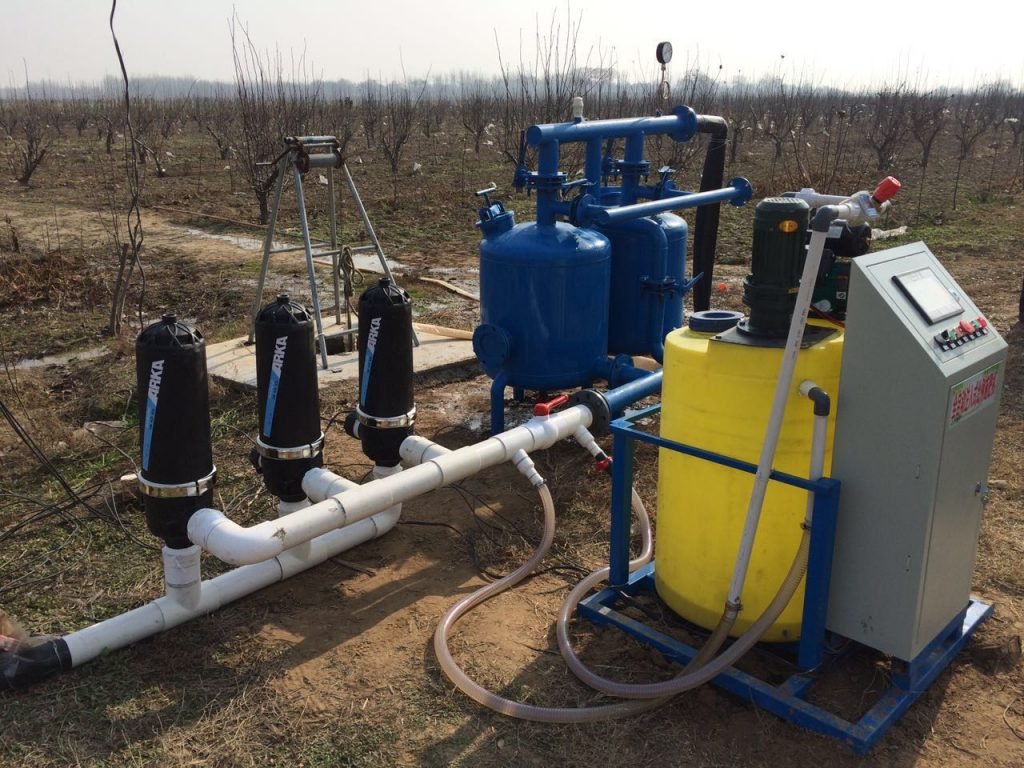
Now, there are many dealers in the market operating water purification equipment using TDS meter (or electrolysis instrument) to test the water quality of water purification equipment, and this index is a measure of all the water purifier quality of the intuitive standard. This is unscientific and misleads consumers’ judgments about healthy drinking water.
TDS meters and water electrolyzers are not used to detect the quality of water, but to detect whether the water contains conductive ions. Pure or ultrapure water containing no conducting ions and small TDS values is not good water for drinking.
The water filtered by the high-quality mineral water, the ultra-filtration membrane, and the ceramic membrane water purifier, which meet the national mineral water quality standard, is drinkable and good, but because it contains beneficial micronutrients and minerals, the TDS values are higher.

